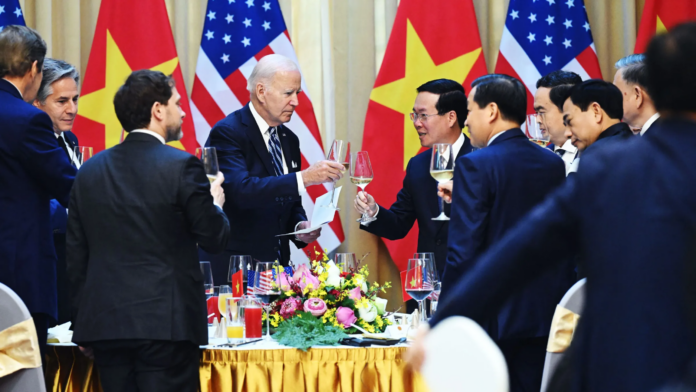The United States is eyeing Vietnam as a potential ally in the tech sector, aiming to diversify its reliance on China’s massive tech supply chain. This strategic move, however, comes with its own set of challenges and complexities.
Last month, President Joe Biden’s visit to Vietnam, accompanied by leaders from major US technology firms like Google, Intel, Boeing, and GlobalFoundries, marked a significant step in this direction. Their unified mission was clear: scout for a new ally in the production of America’s crucial technology components.
The underlying goal of this venture is to minimize the US’s dependency on China. This tactic, known as “friend-shoring,” seeks to identify alternative sources for essential raw materials and manufacturing expertise, particularly in the realm of semiconductors.
As technological and national security tensions between the US and China escalate, the urgency for the US to broaden its supply chain sources intensifies. In response, the Biden administration recently enhanced its chip sanctions against China. Despite the enthusiasm from Vietnam’s government and industries to strengthen ties with the US, experts from both Washington and Hanoi caution that Vietnam isn’t poised to immediately match China’s tech manufacturing capabilities and scale.
The US’s courtship of Vietnam as a tech ally began with treasury secretary Janet Yellen’s visit in July, followed by Biden’s trip, which solidified the partnership further with a $2 million investment to develop Vietnam’s semiconductor workforce.
Vietnam’s ambition to expand its semiconductor workforce tenfold by 2030 is evident. The country’s prime minister, Phạm Minh Chính, recently met with Amkor, a US company, to discuss a $1.6 billion chip testing and assembly factory near Hanoi. This development, alongside the inauguration of a college program in chip design, underscores Vietnam’s commitment to this partnership.
However, the reality of Vietnam’s current role in the technology supply chain necessitates a tempered approach. Questions arise about the extent of Vietnam’s capabilities and the specific steps needed to elevate its role in the global tech landscape. Fully diversifying from China is a daunting task, and neither the US nor Vietnam can completely sever ties with the tech giant.
Vietnam, though strong in math and science education, still has a relatively modest and predominantly low-skilled semiconductor workforce compared to global leaders like Japan and South Korea. The country’s smaller population size and current focus on labor provision rather than integrated circuit production highlight the challenges ahead.
Despite these hurdles, Vietnam’s involvement in global semiconductor-related trade is notable, albeit small compared to China’s dominant position. As one of the world’s top net importers of integrated circuits, Vietnam primarily engages in downstream supply chain activities like testing and assembling chips.
Vietnam’s enhanced partnership with the US could boost its stake in the global semiconductor supply chain. Its strategic location, stable economy, and political environment make it an attractive prospect for US businesses. Analysts suggest that Vietnam can address its high-skilled labor shortage by providing quality STEM education to its young, rural population.
Some US companies have already begun investing in Vietnam, recognizing its potential as a tech hub. Apple, Intel, and other tech giants have made significant investments, signaling confidence in Vietnam’s capabilities.
During Biden’s recent visit, new collaborations were announced, including Microsoft’s development of generative AI for the Vietnamese market and Nvidia’s partnership with prominent Vietnamese firms like FPT and Vingroup.
Despite these advancements, experts caution that the US’s vision of completely decoupling from China’s tech influence remains ambitious. The reality is more about diversification than complete separation. Major corporations, including Apple, continue to maintain a strong presence in China, drawn by its unmatched scale and comprehensive tech ecosystem.
In conclusion, the US’s investment in Vietnam signifies a strategic shift in its technology supply chain, aiming for diversification rather than total disengagement from China. While the road ahead is challenging, the potential for Vietnam to emerge as a significant player in the tech world is undeniable.












